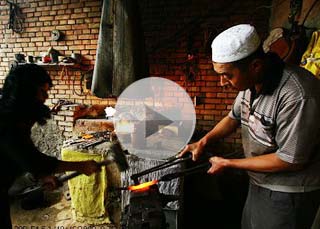------Program code: DO-080828-01586 (what's this?)
Source: CCTV.com
08-28-2008 09:56
A faith that lasts, a symbol that represents a nation, and a pursuit that creates history. Welcome to “The Broadsword of the Bao’an”.
 |
Among all China’s traditional weapons, the broadsword is one of the oldest and most widely used. Historically, the broadsword has been associated with bloodshed and death. Yet in the northwest of the country, a group of people are benefiting economically from its survival and development.
The small town lies beside the Yellow River. Here, even an ordinary street is a place of pilgrimage, where people come seeking a unique symbol of an ethnic group and its past. .
 |
This place beside the Yellow River has the longest name of any county in China. In full, it is Jishi Mountain Bao’an, Dongxiang and Sala Minority Autonomous County. Most of the people who live here belong to the Bao’an Minority – the famous people of the broadsword.
In the Islamic calendar, the ninth month is Ramadan, the month of fasting. Muslims will eat their dinner after sunset, since it is forbidden to eat during the daytime. The day when the fasting ends is celebrated as Eid Al-Fitr, which is one of the three most important festivals in Islam.
Synchronized Voice: Today is an auspicious and happy day for all Muslims.
Following the festival of Eid Al-Fitr, life returns to the streets. The shops, which have been closed during the month of fasting, are open again. Most of the shops here sell one of two items; the famous special zanthoxylum of Jishi Mountain, and the broadsword of the Bao’an.
Sha Xuelin is a restaurateur and businessman. Ten years ago, he started selling the broadswords of the Bao’an and today, he is one of the leading dealers. His biggest markets are Inner Mongolia and Tibet.
Sha Xuelin’s shop is in the town of Dahejia, just beside the Yellow River. Located around Dahejia are the three famous villages of the Bao’an. For centuries, this area has been at the centre of the Bao’an ethnic group’s survival and development.
In the 13th century, a group of Islamic Mongols settled in Tongren in Qinghai Province, and in the Ming Dynasty, they moved on to Bao’an. They established three villages there. In the Qing Dynasty, they migrated again, this time to Jishi Mountain. Following the founding of New China, they were acknowledged as a separate ethnic group – the Bao’an.
Most of the residents of the county are Muslims. But in their dress and what they eat, there is nothing to tell them apart from the other people in the area. There is, however, one difference; the Bao’an people carry a sharp knife with them, known as the broadsword of the Bao’an.
These days, the broadsword is a symbol of the Bao’an people. Its manufacturing technique has been included as part of China’s Intangible Cultural Heritage. Sha Xuelin is happy, because this recognition increases the market for his broadswords.
In Chinese history, there have been three famous blades. The Yingjisha knife of the Uygurs of Xinjiang, the Husa knife of the Achang in Yunnan; and the broadsword of the Bao’an.
The population of the Bao’an ethnic group is less than 20 thousand. They speak their own language, but have no written characters. Agriculture and handicrafts are their main economic mainstay. The broadswords of the Bao’an are so famous that Premier Zhou Enlai would send them as gifts to foreign friends.
It is generally believed that the ancestors of the Bao’an ethnic group were weapons-makers in the Yuan Dynasty. But in an age when strength meant power, their small numbers meant they enjoyed little respect, and they were forced to live as vagrants. In the Ming and Qing Dynasties, they finally settled in the areas they inhabit today.
But on the upper reaches of the Yellow River, the fertile land along the river’s banks was already taken. So the Bao’an were forced to live in the mountain valleys. However, the land there could not produce enough grain to support them, so as a means of survival, they turned to making the handicrafts passed down to them by their ancestors.
In the course of hundreds of years, as the techniques of making the broadswords improved, they became well known across northwest China. Eventually, the broadsword of the Bao’an was recognized as one of the three most famous blades among China’s minorities.
Sha Xuelin is unable to provide his customer with all the broadswords he requested. So he has to purchase some from his own suppliers in the villages.
The three villages near Dahejia are Dadun, Meipo and Ganhetan. In them, almost every home produces broadswords. However, Sha Xuelin is unsure how many he will be able to lay his hands on, because production was halted during the month of fasting.
Among the three famous blades, the husa knife of Yunnan is reputed for its sharpness; the Yingjisha knife is known for its exquisite look; and the broadsword of the Bao’an is known for its durability.
The broadsword developed at a time of relative peace in the country. So it wasn’t designed to cleave; and since Bao’an is located in an undeveloped region, exquisite decoration would be unsuitable. So, the makers of the swords decided to focus on durability.
